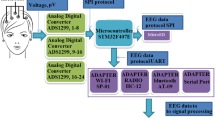Abstract
This chapter presents an energy efficient and flexible multichannel electroencephalogram (EEG) artifact identification software-hardware framework using depthwise and separable convolutional neural networks (DS-CNN). EEG signals are recordings of the brain activities. The EEG recordings that are not originated from cerebral activities are termed as artifacts. Our proposed model does not need expert knowledge for feature extraction or preprocessing of EEG data and has a very efficient architecture implementable on mobile devices. The network presented in this chapter can be reconfigured for any number of EEG channel and artifact classes. Experiments were done with the proposed model with the goal of maximizing the identification accuracy while minimizing the weight parameters and required number of operations. The network presented in this chapter achieves 93.14% classification accuracy using EEG dataset collected by a 64 channel BioSemi ActiveTwo headsets, averaged across 17 patients and 10 artifact classes. The hardware architecture designed in this chapter is fully parameterized with number of input channels, filters, depth, and data bit-width. The number of processing engines (PE) in the proposed hardware can vary between 1 and 16 providing different latency, throughput, power, and energy efficiency measurements. A custom hardware architecture is implemented on Xilinx FPGA (Artix-7) which on average consumes 1.4–4.7 mJ dynamic energy with different PE configurations. Energy consumption is further reduced by 16.7× implementing on application-specified integrated circuit (ASIC) at the post-layout level in 65-nm CMOS technology. The FPGA implementation is 1.7× to 5.15× higher energy efficient than some previous works. Moreover, the ASIC implementation is also 8.47× to 25.79× higher energy efficient compared to previous works. In this chapter, it is also demonstrated that the network is reconfigurable to detect artifacts from another EEG dataset collected in a lab by a 14 channel Emotiv EPOC+ headset and achieved 93.5% accuracy for eye blink artifact detection.
Similar content being viewed by others
References
Abdelhameed AM, Daoud HG, Bayoumi M (2018) Deep convolutional bidirectional ISTM recurrent neural network for epileptic seizure detection. In: 2018 16th IEEE International New Circuits and Systems Conference (NEWCAS), pp 139–143. https://doi.org/10.1109/NEWCAS.2018.8585542
Bhardwaj S, Jadhav P, Adapa B, Acharyya A, Naik GR (2015) Online and automated reliable system design to remove blink and muscle artefact in EEG. In: 2015 37th annual international conference of the IEEE Engineering in Medicine and Biology Society (EMBC), IEEE, pp 6784–6787
Chollet F (2017) Xception: deep learning with depthwise separable convolutions. In: Proceedings of the IEEE conference on computer vision and pattern recognition, pp. 1251–1258
Fan H, Luo C, Zeng C, Ferianc M, Que Z, Liu S, Niu X, Luk W (2019) F-E3D: FPGA-based acceleration of an efficient 3D convolutional neural network for human action recognition. In: 2019 IEEE 30th international conference on Application-specific Systems, Architectures and Processors (ASAP), vol 2160-052X, pp 1–8. https://doi.org/10.1109/ASAP.2019.00-44
Hosseini M, Ren H, Rashid H, Mazumder A, Prakash B, Mohsenin T (2020, in press) Neural networks for pulmonary disease diagnosis using auditory and demographic information. In: epiDAMIK 2020: 3rd epiDAMIK ACM SIGKDD international workshop on epidemiology meets data mining and knowledge discovery, ACM, pp 1–5
Islam MK, Rastegarnia A, Yang Z (2016) Methods for artifact detection and removal from scalp EEG: a review. Neurophysiol Clin 46(4):287–305
Islam R, Hairston D, Mohsenin T (2017) An EEG artifact detection and removal technique for embedded processors. In: IEEE Signal Processing in Medicine and Biology symposium (SPMB), IEEE. https://doi.org/10.1109/SPMB.2017.8257049
Jafari A, Gandhi S, Konuru SH, Hairston WD, Oates T, Mohsenin T (2017) An EEG artifact identification embedded system using ICA and multi-instance learning. In: 2017 IEEE International Symposium on Circuits and Systems (ISCAS). pp 1–4. https://doi.org/10.1109/ISCAS.2017.8050346
Jafari A et al (2019) SensorNet: a scalable and low-power deep convolutional neural network for multimodal data classification. IEEE Trans Circuits Syst I Regul Pap 66(l):274–287. https://doi.org/10.1109/TCSI.2018.2848647
Khatwani M, Hosseini M, Paneliya H, Mohsenin T, Hairston WD, Waytowich N (2018) Energy efficient convolutional neural networks for EEG artifact detection. In: 2018 IEEE Biomedical Circuits and Systems conference (BioCAS), IEEE, pp 1–4
Krishnamoorthi R (2018) Quantizing deep convolutional networks for efficient inference: a whitepaper. arXiv preprint arXiv:1806.08342
Lawhern V, Hairston WD, McDowell K, Westerfield M, Robbins K (2012) Detection and classification of subject-generated artifacts in EEG signals using autoregressive models. J Neurosci Methods 208(2):181–189
Lawhern VJ, Solon AJ, Waytowich NR, Gordon SM, Hung CP, Lance BJ (2018) EEGNet: a compact convolutional neural network for EEG-based brain-computer interfaces. J Neural Eng 15(5):056013. https://doi.org/10.1088/1741-2552/aace8c
Mahabub A (2018) Design and implementation of a novel complete filter for EEG application on FPGA. Int J Image Graph Signal Process 10(6):22–30
Rashid HA, Manjunath NK, Paneliya H, Hosseini M, Mohsenin T (2020) A low-power ISTM processor for multi-channel brain EEG artifact detection. In: 2020 21th International Symposium on Quality Electronic Design (ISQED), IEEE
Ren H et al (2020, in press) End-to-end scalable and low power multi-modal CNN for respiratory-related symptoms detection. In: 2020 IEEE 33rd international System-on-Chip Conference (SOCC)
Sundaram K et al (2016) FPGA based filters for EEG pre-processing. In: 2016 second International Conference on Science Technology Engineering and Management (ICONSTEM), IEEE, pp 572–576
Szegedy C. Ioffe S. Vanhoucke V, Alemi AA (2017) Inception-v4, inception-ResNet and the impact of residual connections on learning. In: Thirty-first AAAI conference on artificial intelligence
Wang P, Jiang A, Liu X, Shang J, Zhang L (2018) LSTM-based EEG classification in motor imagery tasks. IEEE Trans Neural Syst Rehabil Eng 26(11):2086–2095. https://doi.org/10.1109/TNSRE.2018.2876129
Winkler I, Haufe S, Tangermann M (2011) Automatic classification of artifactual ICA-components for artifact removal in EEG signals. Behav Brain Funct 7(1):30
Author information
Authors and Affiliations
Corresponding author
Editor information
Editors and Affiliations
Rights and permissions
Copyright information
© 2021 Springer Science+Business Media, LLC, part of Springer Nature
About this entry
Cite this entry
Khatwani, M. et al. (2021). A Flexible Software-Hardware Framework for Brain EEG Multiple Artifact Identification. In: Sawan, M. (eds) Handbook of Biochips. Springer, New York, NY. https://doi.org/10.1007/978-1-4614-6623-9_21-1
Download citation
DOI: https://doi.org/10.1007/978-1-4614-6623-9_21-1
Received:
Accepted:
Published:
Publisher Name: Springer, New York, NY
Print ISBN: 978-1-4614-6623-9
Online ISBN: 978-1-4614-6623-9
eBook Packages: Springer Reference EngineeringReference Module Computer Science and Engineering




